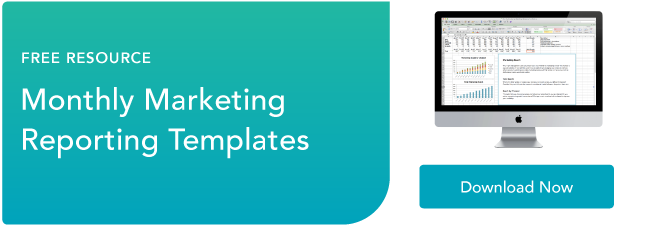- Like
- SHARE
- Digg
- Del
- Tumblr
- VKontakte
- Flattr
- Buffer
- Love This
- Save
- Odnoklassniki
- Meneame
- Blogger
- Amazon
- Yahoo Mail
- Gmail
- AOL
- Newsvine
- HackerNews
- Evernote
- MySpace
- Mail.ru
- Viadeo
- Line
- Comments
- Yummly
- SMS
- Viber
- Telegram
- JOIN
- Skype
- Facebook Messenger
- Kakao
- LiveJournal
- Yammer
- Edgar
- Fintel
- Mix
- Instapaper
- Copy Link
Whether you’re conducting a blog traffic audit or analyzing the success of your most recent social media campaign, it’s undeniable that data is an integral part of any marketing role.
As HubSpot’s Director of Analytics, Bridget Zingale, says, “Reporting and attribution haverevolutionized marketing in every industry. Marketing data allows businesses to make more informed decisions about their audiences’ needs, challenges, and interests.”
Fortunately, there are dozens of analytics tools for marketers with the ability to collect data from different sources, crunch it effectively, and deliver helpful campaign analysis.
Ultimately, reporting tools should do more than just calculate — they should also make the marketer’s job easier, and more productive. Creating attractive and readable reports is key to ensuring that the results of your work are clear for your entire team.
Here, let’s dive into some of the best data reporting tools, as well as some effective business intelligence (BI) platforms, to enable you to properly analyze your work.
Best Business Intelligence & Data Reporting Tools
As Zingale notes, “Data points such as age, ethnicity, gender, location, education, and employment have informed marketing teams and heightened the impact of campaigns across the board.”
Good tools you use should give you the above metrics — but greattools give you more. If you’re one of the 75% of marketerswho report ROI from marketing campaigns, you’re going to need reliable, accurate data. Let’s explore the 14 best tools to help get you the data you need.
Best Data Reporting Tools
- HubSpot
- Calendar
- DashThis
- RavenTools
- Megalytic
- Klipfolio
- Mixpanel
- Intercom
- G2
- Databox
- MaxG
- Microsoft Power BI
- Datapine
- Zoho Analytics
1. HubSpot
Price: Free
HubSpot’sfree marketing analytics softwareis useful for keeping all of your needs, including reporting, in one place. HubSpot lets you combine all of your marketing efforts into one report, or mix-and-match your different assets to create different reports for different clients and needs.
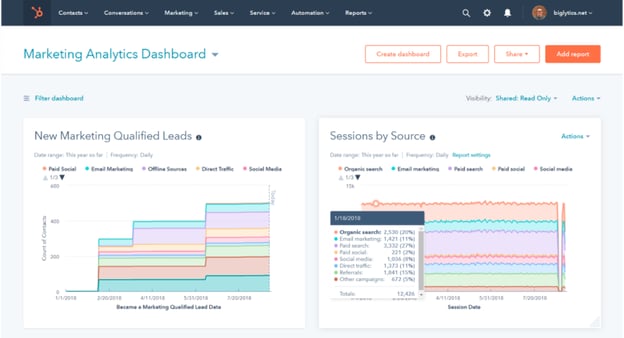
HubSpot’s marketing analytics dashboard is just as customizable, allowing you to add and remove different reports with ease. Best of all, you can get both a general overview and specific insights into your work’s performance, since you can easily move between different marketing reports within HubSpot.
2. Calendar
Price: Free plan, or $6-$8/mo.
Calendar offers analytics of a slightly different sort: productivity. It has a number of features designed to analyze how your team’s time is spent. By tracking your moment-to-moment activities on a daily basis, you can identify key areas in which your schedule could be improved.
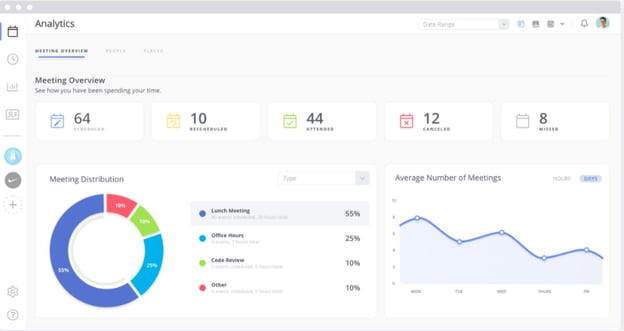
As important as it is to have your marketing analytics at your fingertips, knowing how you use your time is just as important for maximizing output. Calendar’s clear and simple reporting tools give you helpful reports on what your agenda looks like and what you can do to make it better.
3. DashThis
DashThis is an effective tool for keeping up with marketing analytics at a glance. As its name suggests, DashThis is a dashboard that provides clear data on your KPIs for campaigns. You can access quick metrics and reports from your dashboard, shown below:
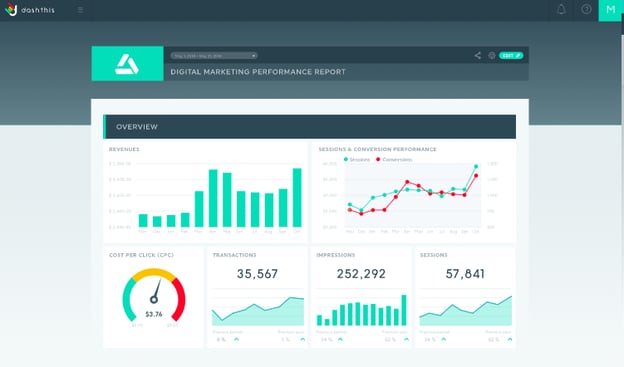
DashThis lets you select a template and then automatically fills that template with your data, greatly streamlining the reporting process. It also exports data into PDF files, which can be easily shared between team members.
4. Raven Tools
Raven Tools offers many of the tools expected from reporting software — SEO analysis, social media engagement, funnel performance tracking — as well as competitor comparison.
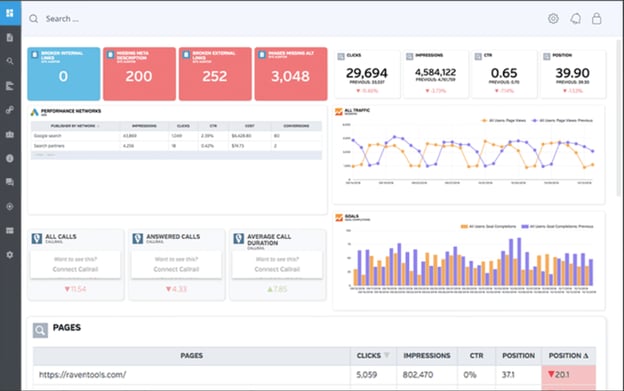
Whether it’s big-picture analyses like domain authority or small-scale comparisons of site functionality, Raven Tools lets you stay on top of how you’re faring in competitive spaces. Additionally, its drag-and-drop editor and report generator makes creating custom, professional-grade marketing reports easier.
5. Megalytic
Megalytic eases the process of combining marketing data from lots of different sources. Plenty of tools on this list allow for the integration of different types of data, but Megalytic is especially designed to import data from a range of marketing software.
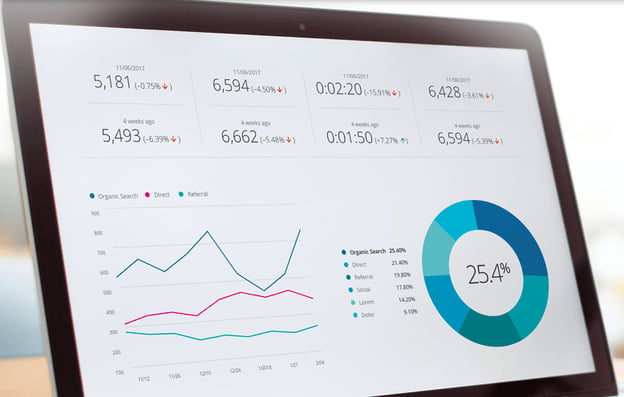
It takes only a couple of moments to access data from Google Analytics, Facebook Ads, Adwords, and more on Megalytic, and it can even process and report data stored in CSV files. If you’re looking to produce a comprehensive report that pulls together loads of disparate data into one place, Megalytic is a smart choice.
6. Klipfolio
As important as it is for reporting tools to effectively take in and analyze data, they need to be able to produce readable reports, as well. Klipfolio is great for making sure your reports can be read and accessed with ease across technologies. Your results can be accessed on a single dashboard that updates in real-time.
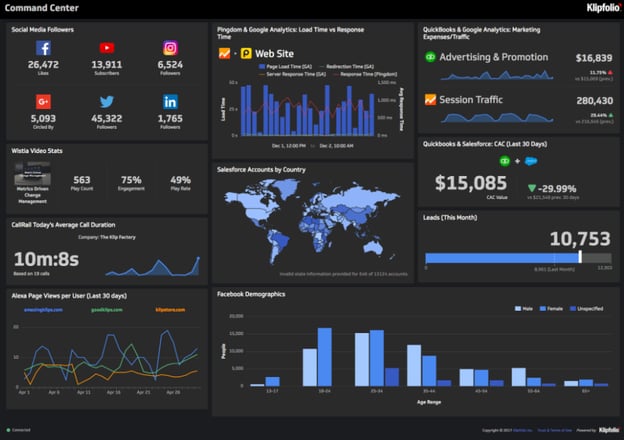
Additionally, Klipfolio allows you to share access to your reports through Slack, email, or custom links, and it also enables you to sync your dashboards in real time across multiple devices such as smartphones, web browsers, and even TV screens. Being able to easily pull up your analytics dashboard at any moment on any number of devices is crucial for being able to report on-the-go or from various locations.
7. Mixpanel
Mixpanel is a tracking and reporting software tool that was initially created primarily for product managers, not marketers. As a result, its interface isn’t as streamlined or marketing-driven as some of the other options on this list, but it makes up for this with powerful analytics tools that give insight into how your work is faring.
Mixpanel is particularly attuned to identifying trends in engagement and count. It tracks how people engage with certain products over time and how different features influence user behavior with bright, colorful graphs.
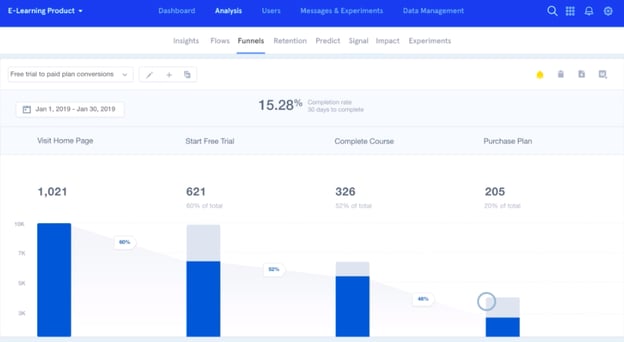
If you’re especially interested in keeping track of how a certain site or product is performing, it can be a valuable tool for reporting on that kind of information. Mixpanel allows you to produce readable reports of uniquely high-level data analysis.
8. Intercom
Although Intercom is a messaging platform first and foremost, it also delivers a deep view of a company’s customer base. Through integrations with over 100 marketing tools, Intercom lets marketers track, segment, and identify similarities between their customers. One of the best use cases for Intercom’s BI features is account-based marketing and messaging.
Intercom displays performance figures for each stage of your sales and marketing funnel, helping you see where the best opportunities lie and how to tap into them. You can also break down metrics by individual representatives, teams, timeframes, and more.
9. G2
Price: Free
G2 is the go-to website for stacking up software tools against one another. G2 gives detailed charts for every category of marketing software, explaining the strengths and weaknesses of each available product.
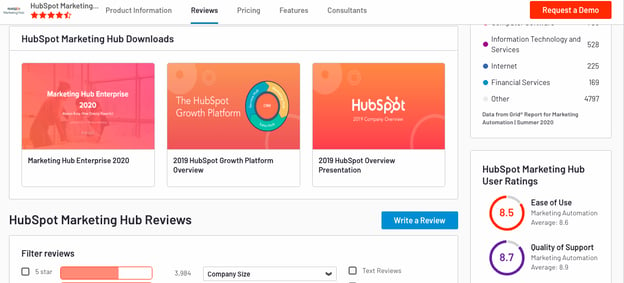
Need an enterprise resource planning tool? G2 covers those. What about an e-commerce platform? G2 can help you pick the best option in that category, too. Certain services, including staffing and translation services, are also reviewed by G2.
10. Databox
Price: Free plan, or $49-$248/mo.
Through integrations with HubSpot CRM, Google Analytics, Facebook, LinkedIn, Instagram, and more, Databox compiles popular marketing services and social media into one interface. It comes with pre-configured report templates, but users can also design custom reports.Think of Databox like a dashboard for your dashboards, where you can see valuable marketing and sales metrics.
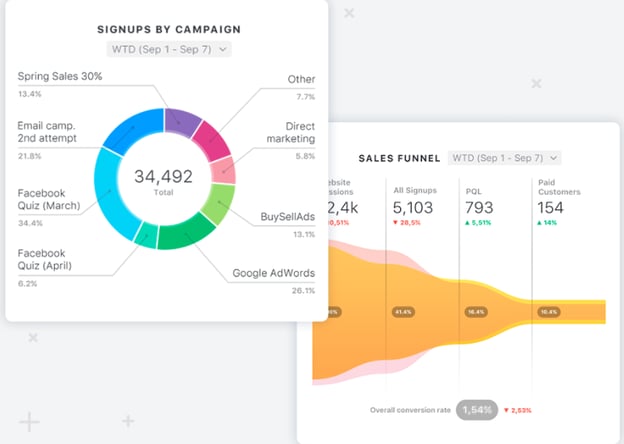
The reporting tool lets you view campaign KPIs, check progress, calculate investment returns, and receive notifications when metrics fall outside of specified ranges. Databox has a desktop version, of course, but it also displays data on mobile and via applications like Slack.
Statisticians and analysts may be more comfortable with reporting and BI than marketers, but these tools make it easy. Pick the right ones, and get data-driven campaign insights with ease.
11. MaxG
Price: Free plan, or $49-$499/mo.
MaxG is a platform that leverages AI to drive results. Their software prioritizes recommendations when delivering insights to eliminate guesswork about how to improve content.
The reports are broken down into metrics, shown below. MaxG’s software keeps track of how many users interacted with various content across your webpages.
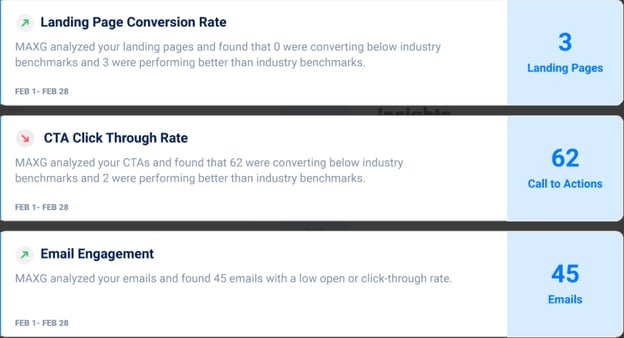
The platform offers insights on multiple metrics, including email campaigns, landing pages, and CTAs. In addition to performance recommendations, the tool also provides resources that educate its users about various topics, like an informative blog post.
12. Microsoft Power BI
This service is offered by Microsoft. If you want to integrate data directly into reports, this is a good tool for you. Power BI is a useful tool, and was formulated by the engineers at the company so users can get powerful, full-scale analytics at a low cost.
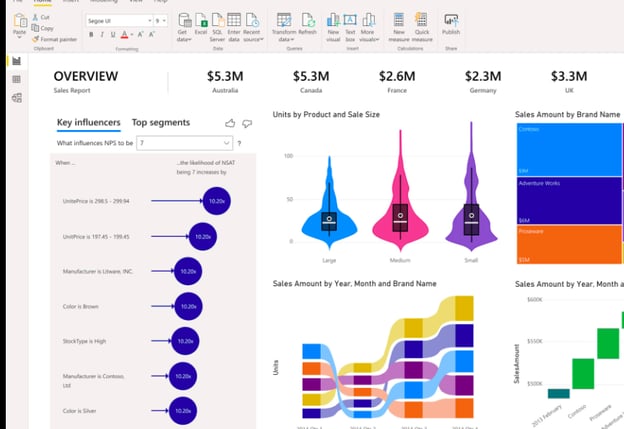
Power BI’s analytics are able to scale for organizations of any size. It boasts built-in AI software that offers custom data metrics. You’ll also have a brilliant display of visualizations to go along with your insights.
You can use Power BI to query your data and edit it without affecting other programs you use. In addition to an Excel integration, the software’s dashboard is easy to navigate.
13. Datapine
With Datapine, you’ll have access to reporting tools that communicate KPIs on a single dashboard. The quick access to real-time, accurate metrics saves you time and keeps your team on the same page.
If you don’t have much technical experience, you won’t have to worry — Datapine is easy to navigate and analyze. The platform is also highly integratable, so you can customize results from other sources.
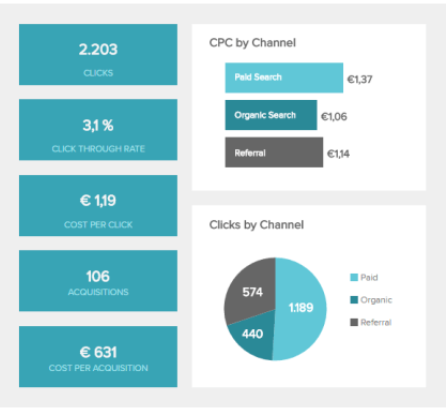
Personalize further by dragging and dropping KPIs that mean the most onto your dashboard. Datapine gives you access to a global performance filter and predictive analysis. Essentially, the AI-powered software combs through data and suggests improvements.
Let’s say you need an inclusive, sophisticated report that’s quick to gather. Datapine lets you export dashboards by emails, URL, or with an embed code, which is handy for your presentation.
14. Zoho Analytics
Zoho Analytics is a part of the larger Zoho Cloud software suite. With it, you can synchronize data that’s spread across multiple sources. The data will sync on a periodic basis so you won’t have to worry about continuously deducing the numbers.
Like other platforms, Zoho’s reports are completely customizable. Some of the options you can include are split columns, cleanup data, and calculated fields. This is so you can receive the data that matters most to your business goals.
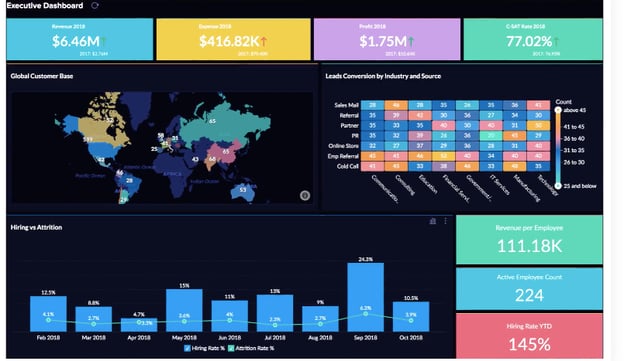
If you want to compare data from multiple sources, add lookup columns so they’ll be included in reports. As another feature of reports, format the data to your liking. With over 40 chart types, like geographical maps, funnels, tables, and heat maps, reports can be extremely detailed and streamlined.
As marketers, we use data daily. It’s an integral part of what we have to do for our jobs. That’s why it’s a necessity to have data that works for you.
If, right now, your data reporting tool is nothing short of a headache, one of these tools can be a great places to start. They’re going to offer you personalized results that you can share with your team, which will keep everyone aligned.
Originally published Jul 30, 2020 4:30:00 PM, updated July 30 2020


